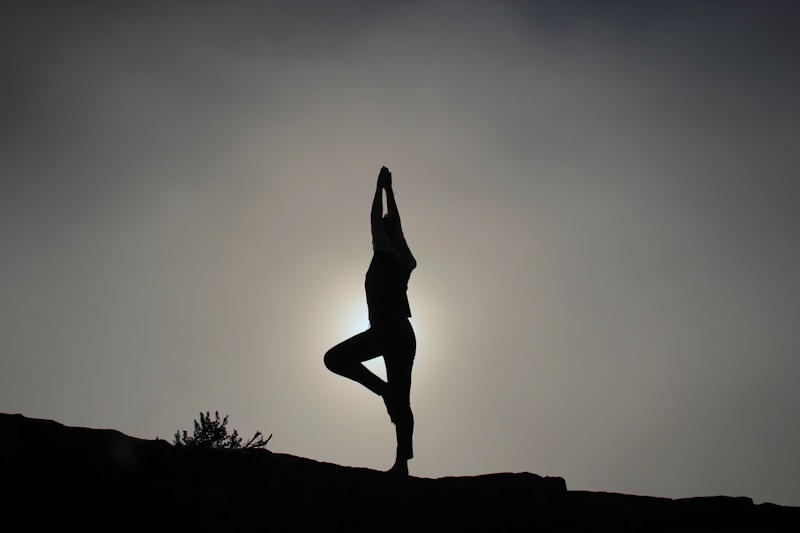It’s very difficult to get the balance right these days. Either you’re doing too much or you’re not doing enough. In my household, I tend to fall into the ‘too much’ camp, and my husband tends to fall into the ‘too little’ camp.
Being creatures of habit, we take these tendencies into our yoga practice too, so I find it hard to commit to a restorative yoga practice, or make sure that I have a proper rest in śavasana at the end of my home practice, because it doesn’t feel like doing.
However, imagine my joy when I found a yoga book (in a charity shop) that could help both of us. This book was aptly titled: Yoga for Wimps.
About the Book
Don’t be put off by the title, as this book is a must-have, especially for those thinking of establishing a home practice but not quite sure how to go about it. Using everyday objects that can be found around the house, Yoga for Wimps provides accessible yoga for everyone to have a go at. Whether you’re a beginner, advanced practitioner or even a teacher, this book is a great reminder that yoga can be simple, useful and quick. Originally published in 2000 it already looks incredibly dated, but the poses themselves are 5,000 years old, so we don’t need to get too hung up about how it looks.
Loosely based on the Iyengar yoga discipline, the poses are grouped into quick sequences with large colour photographs of each pose. Ends of sequences are clearly marked when the person modelling the poses changes. There are clear instructions for each pose, with helpful tips for how to make the pose more comfortable or what to do if your body can’t recreate picture. Reassuringly, for those readers that aren’t flexible, the models are a motley crew of ordinary mortals rather than super-bendy acrobats.
The book is split roughly into two halves, beginning with warm-ups and a series of easy-to-follow sequences. The second half of the book is grouped under the heading “Fix-Its”, which include sessions with titles such as “The Cure for Museum-itis”, “The Lower Back Blues”, and “I’m Fried!” For those that dig the detail, there’s a glossary of the author doing all the poses, plus their proper names in English at the back.
Enjoy Wimping Out!
Yoga for Wimps gives you permission to wimp out if you’re the kind of yogi that would rather push through. By taking your practice right back to the basics you remember that it’s not about how hard you can cane your body, but about the simple things such as opening your chest, lengthening the back and relaxing just a little bit more with each exhalation.
My teacher training mentor, in her wisdom, said that it’s very important to fit at least one restorative session into our home practice each week. If we don’t make time for restoring the body and allowing the deep rest that yoga can provide, we open ourselves up to the possibilities of long-term injuries and ill-health.
Take the example of a Seated Forward Fold (Paśchimottanāsana), which is often a competition about how closely people can resemble a flat pack. Miriam’s advice in this pose is, ‘Go slowly! This is not a contest to see how far down you can get – a long, straight back is most important.’ The same is true of all yoga poses. Yoga is not a competition. Rather, it’s about pushing ourselves gently that we reap the full, long-term benefits.
Encourage Others to Give Yoga a Go
Who’s got a friend, parent or partner who insists that they’re just not the flexible enough to do yoga? You’ve told them that yoga is even more suitable for them, but they just don’t believe you. Try leaving this book somewhere convenient for them! The shorter sequences take as little as 5–10 minutes, and you don’t even need a mat. Plus, the poses are taken right back to their simplest form, and are often shown against the wall, or using a chair, which reduces the risk of injury.
There are sequences that you can do during your lunch break, first thing in the morning or even while watching TV. So that puts the “I simply don’t have time” excuse to an end. Plus, the instructions are encouraging and positive. In a seated Upward Salute (sitting in a chair, reaching your arms up the wall) she tells the reader, “Once you think your fingers are as high as they can be, walk them a little higher.”
It’s not the complete yoga guide, but it’s a start…
I’m not saying that this is the only yoga book you’ll ever need, and it’s certainly not a substitute for going to a regular class with a qualified teacher – but for those of us:
a. just thinking about establishing a home practice,
b. that would like to give yoga a go but feel intimidated, or,
c. that think we know all there is to know, and maybe just need a little, gentle reminder to go back to basics,
this book can be a very helpful tool. We would definitely recommend checking it out!












